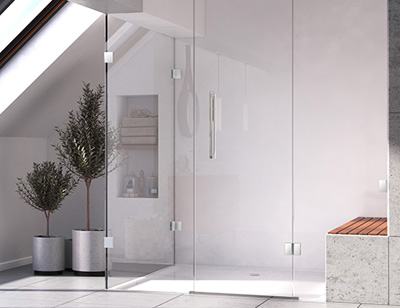- Matt R.
- Shower Trays
- 199 views
A wet room can completely transform your home’s bathroom experience, offering a walk-in style that’s practical, stylish, and versatile. In this article, you’ll discover what a wet room actually is, why it’s such an appealing choice for various living situations, and how it compares to a traditional bathroom. By reading, you’ll understand the core elements and installation considerations of a wet room, along with advice on deciding whether it’s the right solution for your unique needs. If you’ve ever wondered about walk in showers, wet room showers, or how to create a barrier-free bathroom design, this post is for you!

Table of Contents:
What Is a Wet Room?
A wet room is a room in your home – often replacing or enhancing a standard bathroom – where the shower area has no raised shower tray or significant threshold. Essentially, the floor is sloped toward a drain, allowing water to flow away unobstructed. Unlike conventional shower enclosures, a wet room typically relies on an open-plan concept, sometimes with minimal walk in shower screens or partial partitions. Many homeowners love the sleek and modern vibe these spaces provide.
How a Wet Room Differs from Traditional Showers
- No Full Enclosure: The shower zone is either left open or partially enclosed by glass panels to prevent leaks while maintaining an airy feel.
- Sloped Floor: The floor is carefully angled toward a drain, allowing water to walk straight off the surface.
- Accessible Layout: Without raised edges, wheelchair users, people with mobility challenges, or those who prefer easy access can move in and out effortlessly.
Why a Wet Room Is Worth Considering
The main attraction is the ability to create a shower space that feels open and seamlessly integrated into the bathroom. You get a unique style that can range from minimalistic to ultra-luxury, and the design is highly adaptable. Whether you have a small bathroom or larger spaces, the concept of a wet room can be tailored to suit your lifestyle.

Wet Room Elements – Key Components, Appliances, and Enclosures
Wet Room Shower Tray
At the heart of every wet room lies the wet room shower tray – a fully integrated base that ensures water flows smoothly toward the drain. Unlike a bulky, raised enclosure, this specially designed tray merges with the bathroom floor, creating a sleek, barrier-free shower area. It’s the key component that separates a true wet room from a standard shower by delivering the precise slope and water containment needed to keep the space functional, safe, and thoroughly waterproofed. Without a wet room shower tray, the open-plan, walk-in concept simply wouldn’t be possible. Wet room shower trays come in a variety of sizes, offering flexible options to accommodate diverse bathroom layouts and user preferences.
See our range of wet room shower trays

Drain
An efficient drain is pivotal in any wet room, ensuring water flows away quickly and effectively. Drains come in linear or point configurations and can be integrated with the wet room shower tray or purchased separately. They may be finished to match the surrounding floor – be it tiles, vinyl, or microcement – or left in stainless steel with a choice of gold, brass, black, or silver coatings for a seamless yet distinctive look. Drains are available in a wide range of models, ensuring there’s an ideal solution to suit every style preference, budget, or technical requirement.
See our range of wet room drains

Enclosure
Though many wet rooms are open plan, you can still include partial wet room screens or walk in shower enclosures if you want to contain splashing water or maintain privacy. Typically, these partitions are made of safety glass or toughened safety glass for durability. If you prefer more coverage, you could add shower doors, but the minimal approach – using a simple shower screen – is popular for a wet room.
See our range of wet room shower screens

Appliances
The appliances in a wet room might include a shower head column – overhead or handheld, depending on your preference. You might also incorporate specialized fixtures such as a shower seat for those with mobility concerns or a shower with multiple jets for a spa-like experience. Ensure your lighting and electrical points are installed with professional guidance to prevent leaks and avoid water damage.

Wet Room vs Bathroom – What’s the Real Difference?
Homeowners often ask, “Is a wet room better than a traditional bathroom?” This is a common question, especially when deciding how to optimize your bathroom floor layout. The answer depends on your personal preferences, the space you have available, and whether you want to emphasize walk in showers or keep your existing bath configuration.
Difference #1: Design and Layout
A standard bathroom typically features a shower enclosure, a bath, and maybe a shower seat if accessibility is a concern. In contrast, a wet room eliminates many of these boundaries. There’s no standard shower tray, and your shower might be integrated directly into the floor. This layout is especially beneficial for those with mobility issues or those desiring a modern open plan.
Difference #2: Cost Considerations
Cost is influenced by factors such as the size of your room, required materials (like toughened safety glass and waterproof fixtures), and the complexity of the installation. Sometimes a wet room might be more expensive initially due to high-quality waterproofing requirements, but it can add long-term value if executed professionally.
Difference #3: Who Benefits from a Wet Room?
- Wheelchair users and people with mobility challenges appreciate the easy entry and easy access design.
- Homeowners seeking a stylish, modern upgrade find that a wet room offers a sleek alternative to a conventional bathroom.
- Households with limited bathroom space often find that removing a bulky bath can free up a surprising amount of room.

Why Choose a Wet Room. Benefits and Suitability
Still uncertain if a wet room suits your bathroom design ideas? Here’s a look at why this modern, open-plan style is so appealing:
- Enhanced Accessibility and Mobility
A wet room is an excellent choice if you or your loved ones want easy entry without the barriers of a raised shower tray or bath edge. Wheelchair users appreciate the unobstructed floor plan, and you can easily incorporate a shower seat, grab bars, or other supportive features. Even if you have no immediate mobility concerns, adding accessibility elements can future-proof your bathroom and accommodate guests with varying needs. - Minimalist and Modern Style
If you’re looking to create a sleek, modern environment, a wet room offers an uncluttered look. You can do away with bulky doors and shower enclosures, letting you embrace a spacious, walk-in format. Whether you gravitate toward rustic stone or glossy porcelain tiles, the design possibilities are extensive. By matching the wet room floor with the rest of your bathroom aesthetic, you’ll gain a unified, high-end finish—one that many homeowners find both stylish and timeless. - Perfect for Large and Small Spaces
TOne myth is that you need a huge bathroom for a wet room. In reality, small spaces can benefit just as much - especially if you remove a bath or bulky fixtures to open up the floor plan. In larger spaces, a wet room lets you go all-out: consider walk in shower enclosures or double shower heads for a real spa vibe. The flexibility of wet room design makes it easy to tailor the layout to your specific needs and your home’s dimensions. - Easy to Clean and Maintain
Because there are fewer edges and corners, regular cleaning becomes less time-consuming. Rinse the floor and walls after each shower, and you’re mostly good to go - no dealing with mold lurking behind doors or curtains. Proper installation ensures your wet room remains water-tight, helping to prevent leaks and other moisture-related issues over the long term. - Stylish Design That Stands Out
A wet room can match nearly any bathroom design theme. Whether you want industrial-chic with dark slate, bright gold for style, or something in between, you’ll find it straightforward to mix and match finishes. The integrated drain and open floor setup can add a touch of luxury, appealing to those who want an inviting, contemporary space. Not only does this distinctive look serve your everyday needs, it can also intrigue future buyers should you ever decide to sell.
Read more about wet room advantages.
Key Takeaways About Wet Room
- A wet room is an open-plan bathroom style with a sloped floor that channels water to a drain, removing the need for a high shower tray or doors.
- Ideal for mobility and accessibility needs, as the continuous floor and minimal barriers offer easy entry for wheelchair users or those with mobility challenges.
- You can include partial shower enclosures or wet room screens made from toughened safety glass to keep water in the shower space.
- Proper waterproofing is vital to prevent leaks, maintain structural integrity, and reduce the possibility of mold or water damage.
- A wet room works in both small bathrooms and larger, luxury settings. The style is flexible, letting you create a unique look that can suit your preferences, from minimal to extravagant.
- Although a wet room can be more expensive upfront, its modern, barrier-free design may boost your property’s appeal and offer convenience in the long run.
Whether you have small spaces or desire a larger open layout, a wet room could be the perfect bathroom solution for your home - especially if you value walk in showers, a sleek aesthetic, and easy access for every family member.

FAQ: Common Questions About Wet Rooms
What is the point of a wet room?
The point is to create a more open, accessible, and water-friendly bathroom that does away with raised edges and shower trays. You get a shower area that’s integrated into the floor, often suiting those with mobility challenges or homeowners desiring a modern flair.
Is a wet room better than a bathroom?
It can be, depending on your preference. Some people prefer a classic tub or a defined shower enclosure, while others love the walk in showers approach offered by a wet room. A wet room is beneficial for wheelchair users, or people who want a stylish, open-plan bathroom solution.
Can a toilet go in a wet room?
Absolutely. Many wet rooms incorporate a toilet, sink, and open shower layout in one contiguous room. Proper waterproofing is key to prevent leaks around the toilet area.
Does a wet room devalue your house?
Not usually—if installed correctly, it might even enhance the property’s value by providing a luxury, modern aesthetic. However, if it’s poorly installed it might be less appealing to some buyers.
Is a wet room cheaper than a walk-in shower?
Costs vary depending on materials, labor, and the range of finishes you decide to use. While a basic walk-in shower might be simpler to install, a wet room can cost more if your floors need significant modifications.
What is the disadvantage of a wet room?
Potential downsides include the risk of water splashing around the entire room if not partitioned properly, and typically a more intricate waterproofing installation. Some users also find the open layout results in cooler temperatures once the shower is turned off, whereas a fully enclosed stall tends to retain warmth longer, making toweling off more comfortable.



